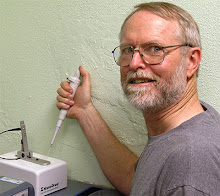A reader (Jay Bryant) recently pointed out a PNAS article on the structure of a bacterial enzyme that uses sucrose to make the glucan matrix of dental biofilms. This article released a cascade of associations in my mind and illustrated why honey does not contribute to dental plaques, but is antimicrobial and aids wound healing. People forget that sugars combine both hydrophilic and hydrophobic properties, and thereby act as soaps.
The starting point of the chemical versatility of carbohydrates is the inability of the central portion of a sugar ring structure to form hydrogen bonds. Each sugar is made of a linear chain of carbon atoms with each carbon linked also to a hydrogen and a hydroxyl. Only the hydroxyl can participate in hydrogen bonds, so each carbon has a hydrophilic side (bonds with water to make hydrogen bonds) and a hydrophobic side (that makes van der Waals bonds with other hydrophobic molecules.) The sugars circularize and the rings have faces that are predominantly hydrophobic and perimeters with hydroxyls that are hydrophilic. Polysaccharides (long chains of sugars), such as cellulose, can sometimes form long fibers that form a hydrophobic context for hydrogen bonds between the hydroxyls of adjacent polymers. These cellulose fibers are very resistant to chemical or biological attack and accumulate as the most abundant biological molecules on Earth.
The PNAS article provides another example of how protein enzymes interact with carbohydrates, in this case sucrose and a polymer of glucose. Typical weak bonds between the amino acid residues of proteins and other molecules are hydrogen, ionic or van der Waals bonds with energies of a couple of kcals/mol. In contrast, the bonding of the hydrophobic face of a sugar to the hydrophobic face of an hydrophobic amino acid, e.g. tryptophan, phenylalanine, histidine, lysine or arginine, releases more than ten kcals/mol of energy. Thus, the structure of the bacterial enzyme that makes biofilm glucan chains from dietary sucrose, the sucrose is bound to the enzyme on the face of a prominent tryptophan. Examination of enzymes that bind to polysaccharides will show a series of tryptophans arrayed across the surface of the enzymes with spacing appropriate to bind to the individual sugars of the polysaccharide.
Biofilms are communities of multiple species of bacteria held together by a polysaccharide matrix. In the case of dental plaque, the polysaccharide is made of glucose links, whereas many other matrix polysaccharides are negatively charged and held together by positively charged metal ions. The bacteria bind to the polysaccharides using protein receptors that exploit the display of hydrophobic binding sites of the polysaccharides. It takes energy to make polysaccharides and the dental plaque bacteria use the energy already expended in the formation of sucrose to produce a polymer of glucose, an alpha-glucan, and free fructose. Thus, sucrose is essential in forming this type of biofilm and without this sugar, the dental plaque cannot form. Milk lactose, or glucose would be a more appropriate sweetener. Unfortunately, high fructose corn syrup would be a poor substitute, because of the high liver toxicity of the fructose (it causes fatty liver, just like alcohol) and very high activity in forming advanced glycation end products (AGEs), which contribute to the symptoms of diabetics.
Honey seems to be magical, because at low concentrations the sugars present in honey (mostly glucose and fructose, and not sucrose) are nutrients for bacteria, but at high concentrations honey is anti-bacterial and useful as a wound treatment. I think that the explanation for its antimicrobial activity is that sugars are amphipathic, that is they have both hydrophilic and hydrophobic properties, just like soap, and at high concentrations they kill bacteria, just as soaps at high concentrations kill bacteria. In fact, the gentle soaplike properties of sugars are exploited experimentally to dissolve proteins that are normally embedded in cellular membranes. This explanation predicts that corn syrup, which can also be used to form very stable soap bubbles, should also be useful in wound healing.

